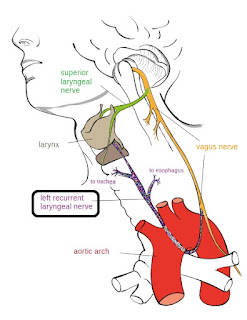Speaking out on the Recurrent Laryngeal Nerve
Although we are going to delve into some in-depth biology, there is no need to be intimidated by the jargon. The recurrent laryngeal nerve involves the operation of the larynx, informally called the voice box. I had to look up why it is "recurring", which is based on the Latin re curr, meaning it loops into the opposite direction.
We have discussed dysteleology before, which is the idea that the Master Engineer fouled up, so he does not exist. (Interesting that secularists praise the grandeur of evolution, but blame alleged bad design on the Creator.) "Bad design" claims keep getting refuted because misotheists and other Darwinists are arguing from ignorance and incomplete information. The RLN is subject to this attack.
 |
| Recurrent laryngeal nerve, WikiComm / Jkwchui from Truth-Seeker2004 (CC BY-SA 3.0), I modified it for visibility |
Evolutionists often cite the recurrent laryngeal nerve (RLN) as evidence of “poor design.” This article evaluates the physiological role of the RLN in its innervation and regulation of the larynx (voice box). Beyond the larynx’s role in speech, it plays a vital role in regulating the flow of air into the trachea (windpipe) and food into the esophagus (food pipe). A closer look at the RLN reveals that, in its “detour” around the subclavian artery on the right and the aortic arch on the left, there are many additional branches that interact with not only the heart and aorta but cervical regions of the trachea and esophagus—organs that depend intimately on the functionality of the larynx to protect the airway and promote swallowing. The rare incidences of non-recurrence in the RLN, as well as incidences of damage to the RLN, afford a means to explore the critical role these afferent pathways play in the coordination of these functions. Embryological developmental constraints are considered as well—particularly, the role the recurrent nature of the RLN may play in the closure of the ductus arteriosus after birth. This supporting evidence makes it difficult to believe that the placement of the RLN was a mistake or a coincidence but rather a detour by design. The scientific community is encouraged to delve deeper into the role of afferent innervations of the RLN in support of healthy physiological functions.
To read the rest, see "God’s Design: Strategic Routing of the RLN." For a previous post, see "Foolish Evolutionists Claim 'Poor Design'"